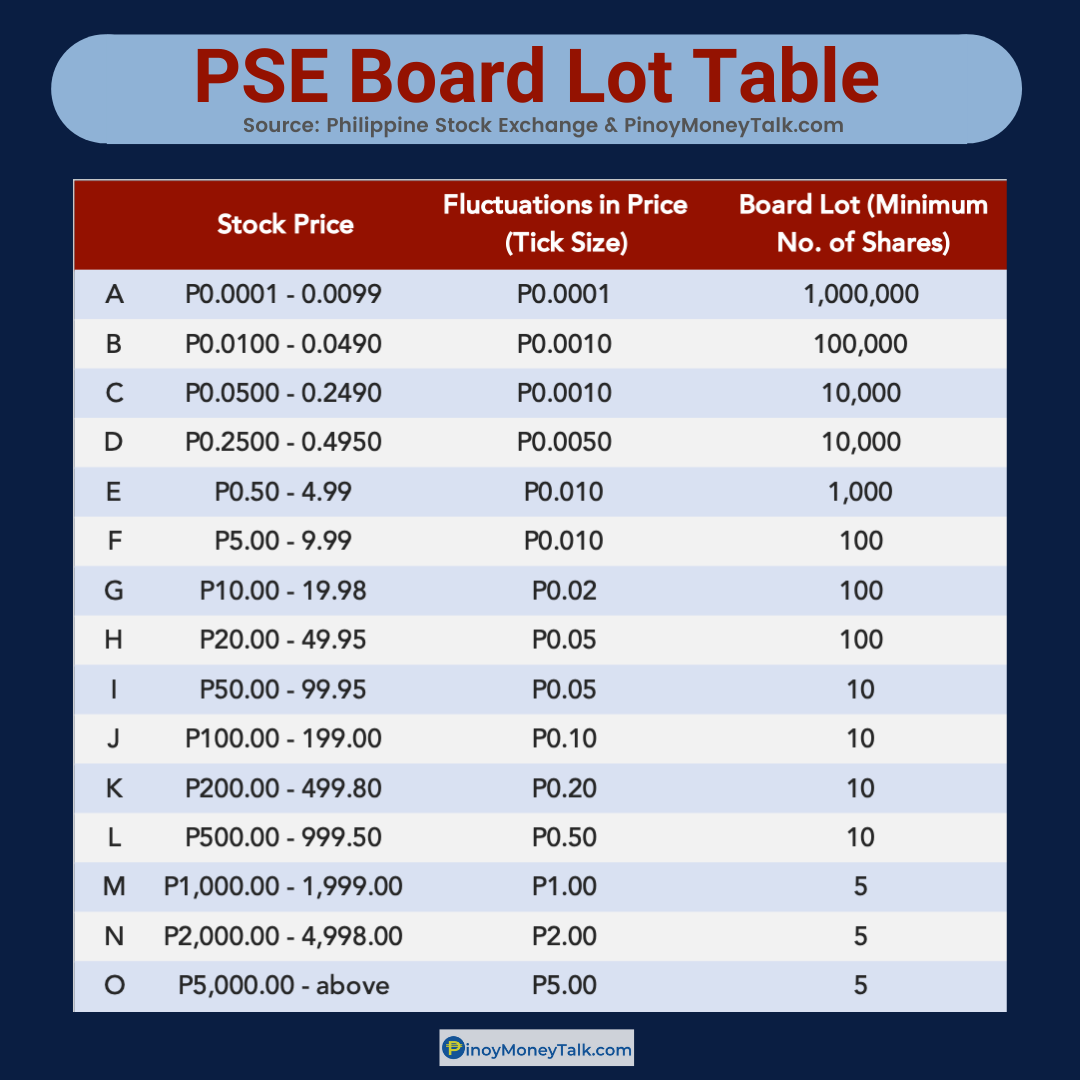Ever wondered how much you need to start trading stocks on the Philippine Stock Exchange (PSE)? Or how many shares of Globe Telecom (GLO), Ayala REIT (AREIT), DITO CME Holdings (DITO), or Megaworld (MEG) you can buy or sell at once?
The answer lies in the PSE Board Lot Table. Read on to find out how you can use the board lot table in your stock trades in the Philippines.

Check out these other useful resources on stock trading:
- The Emotional Cycle of Investing: Why People Lose Money in Stocks
- PSE Stocks Performance under each Philippine President (from 1987 to 2021)
- PSE Stock Trading Fees and Charges (with Sample Computations)
- My stock got delisted, what should I do?
- Stock Tips and Recommendations — FREE!
What is the PSE Board Lot Table?
The Board Lot Table is a guide for investors that indicates the:
- Minimum number of shares that can be bought or sold at any given time; and
- Minimum price increments for each stock traded on the PSE.
Here’s what the PSE Board Lot Table looks like.

How to Read the PSE Board Lot Table
| Stock Price | Fluctuations in Price (Tick Size) | Board Lot (Minimum No. of Shares) | |
|---|---|---|---|
| A | P0.0001 - 0.0099 | P0.0001 | 1,000,000 |
| B | P0.0100 - 0.0490 | P0.0010 | 100,000 |
| C | P0.0500 - 0.2490 | P0.0010 | 10,000 |
| D | P0.2500 - 0.4950 | P0.0050 | 10,000 |
| E | P0.50 - 4.99 | P0.010 | 1,000 |
| F | P5.00 - 9.99 | P0.010 | 100 |
| G | P10.00 - 19.98 | P0.02 | 100 |
| H | P20.00 - 49.95 | P0.05 | 100 |
| I | P50.00 - 99.95 | P0.05 | 10 |
| J | P100.00 - 199.00 | P0.10 | 10 |
| K | P200.00 - 499.80 | P0.20 | 10 |
| L | P500.00 - 999.50 | P0.50 | 10 |
| M | P1,000.00 - 1,999.00 | P1.00 | 5 |
| N | P2,000.00 - 4,998.00 | P2.00 | 5 |
| O | P5,000.00 - above | P5.00 | 5 |
1. Stock Price Column
The “Stock Price” column shows the price range for a PSE-listed stock. Based on current price, it points you to the row where you can find both the allowed price fluctuation (called the “tick size”) and the minimum tradable shares (called the “board lot”).
So for a stock trading at P3.00 per share, refer to Row E (P0.50-P4.99) to find the relevant tick size and board lot.
2. Fluctuations in Price (Tick Size) column
The “Fluctuations in Price” or “Tick Size” column shows how much a stock’s price may move. Row E, for instance, applies to stocks priced between P0.50 and P4.99 and limits price changes to P0.010 increments.
Similarly, a stock trading at P5,100.00 can only move in increments of P5.00 (as indicated in Row O). This means the stock can trade at P5,105.00, P5,345.00, or P4,855.00—since these values are divisible by P5.00. However, it cannot trade at P5,103.00, P5,501.25, or P6,557.00, as these figures are not divisible by the required tick size of P5.00.
3. Board Lot (Lot Size) column
Finally, the “Board Lot” or “Lot Size” shows the minimum number of shares you can trade based on a stock’s price.
For example, Row E specifies that stocks within this price range must have a board lot of 1,000 shares. This means you’re allowed to trade in multiples of 1,000, i.e., buy or sell 2,000 shares, 5,000 shares, or even 30,000 shares of such stock.
We’ll see a clearer application of the Board Lot Table in the following examples.
The “Odd Lot” Market
Note: Take note that the Board Lot Table only applies to “Normal Lot” trades in the PSE, which differ from trades in the “Odd Lot” market. An odd lot refers to a number of shares less than the standard trading unit as identified in the Board Lot Table. We’ll discuss odd lots in a separate article.
For now, pop quiz! What’s the board lot for a stock trading at P2.00 per share?
(Refer to the Board Lot Table to answer the question. Continue reading if you want to know the answer already.)
This falls under Row E in the Board Lot Table, which indicates that the minimum lot size is 1,000. Any quantity of shares that is not a multiple of 1,000 is considered an odd lot.
As you can see in the sample Odd Lot order below for Megaworld Corporation (MEG), both the Bid Volume (Bid Vol) and Ask Volume (Ask Vol) are in quantities not divisible by 1,000, such as 250, 900, 999, and 1,900. These are examples of odd lot orders.

Odd lot orders typically have slightly different prices compared to Normal Lot orders. The number of orders (and consequently, fulfilled trades) is also often lower since fewer traders use the Odd Lot Market.
Don’t worry, though since most of the time, you’ll be trading “normally,” so for now, you only need to understand the “Normal Lot” version of the PSE Board Lot table.
Uses of the PSE Board Lot Table
The PSE Board Lot Table serves three key purposes:
(1) Determining the minimum number of shares that can be traded for each stock.
(2) Identifying the minimum price fluctuation or increment applicable to each stock.
(3) Calculating the minimum amount of money required to buy any PSE-traded stock.
Let’s explore three examples that demonstrate how to use the PSE Board Lot Table to determine these items.
1. Minimum number of stocks to buy (or sell) in the PSE
To determine the minimum number of shares that can be bought or sold, follow these steps:
Step 1: Get the current price of the stock. Let’s say you want to know the minimum tradable number of shares of Globe Telecom (GLO). Check the PSE website or your broker’s website to get GLO’s current price. Let’s assume GLO is currently trading at P2,200.00.
Step 2: Locate the corresponding row in the PSE Board Lot Table. GLO’s stock price of P2,200.00 corresponds to “Row N”, which covers the price range of P2,000.00 to P4,998.00.

Step 3: Find the Board Lot (Lot Size) column for this row. In the case of GLO, the lot size is 5. This means you are allowed to buy or sell GLO shares in multiples of 5.
Are you permitted to sell 50 shares?
Yes! The lot size is a minimum, so you can sell any number of shares as long as it is divisible by 5.
Can you sell two (2) shares of GLO? No, not in the Normal Lot market. (Take note, however, that you can trade such quantities in the Odd Lot market.)
Easy, right? Now let’s explore the other applications of the Board Lot table.
2. Allowed stock price changes in the PSE
Let’s say you previously bought shares of SM Prime Holdings (SMPH) and now you want to sell them to lock in the profit. The stock currently trades at P36.15 per share. Can you sell your shares at P36.48? How about at P37.25?
To determine the allowed price increment or price change for any give PSE-traded stock, use the Board Lot Table and refer to the Fluctuations in Price or Tick Size column. Follow these steps:
Step 1: Find the current price of the stock. In the case of SMPH, let’s assume its current price is P36.15.
Step 2: Locate the corresponding row in the PSE Board Lot Table. The relevant row is Row H, corresponding to SMPH’s price which is within the price range in that row (P20.00 to P49.95).

Step 3: Identify the Minimum Price Fluctuation (Tick Size) for this row. Row H tells us that the required tick size is PHP 0.05. This means that the allowed price increments must be in multiples of 0.05.
So, going back to our question earlier: can you sell SMPH at a price of P36.48?
No, because P36.48 is not divisible by 0.05.
Can you sell it at P37.25? Yes! Since this price is divisible by 0.05.
Understanding the Board Lot Table is helpful especially when placing a Limit Order, where you specify your desired buying or selling price for a stock.
3. How much money needed to invest in the PSE
How much money do you need to buy stocks in the PSE?
To open a stock trading account in the Philippines, your broker may require a certain amount as initial deposit. But once your account is set up, the minimum amount you need to start trading stocks will depend on the price of the stock you wish to buy and the corresponding board lot.
Here’s an example below.
Let’s say you have decided on making your very first trade: buying the minimum number of shares of Megaworld Corp. (MEG). Follow the steps below to calculate the amount you need.
Step 1: Get the current price of the stock. Simply check the PSE website or your broker’s website to get the current price of a stock. In the case of MEG, let’s assume it is currently trading at P3.35 per share.
Step 2: Determine the lot size from the PSE Board Lot Table. Refer to the process outlined in our earlier examples to find this information.
Checking MEG (with an assumed stock price of P3.35) in the Board Lot Table, we find that its board lot size is 1,000 shares, as indicated in “Row E”.

Step 3: Multiply the current price by the minimum lot size. This gives you the amount of cash you need to be able to buy the stock.
For MEG, the calculation is: P3.35 (current price) × 1,000 (minimum board lot shares) = P3,350. Therefore, you need P3,350 to purchase the minimum number of MEG shares.
As you can see, the PSE Board Lot Table is a valuable tool for calculating the minimum investment needed to start trading.
But wait, there’s more!
Take note that stockbrokers like COL Financial, GStocks, BPI Trade, PhilStocks, First Metro Securities, and Dragonfi Securities charge broker’s commissions, which will increase your total cost. The government also charges taxes on buying and selling transactions.
To understand these fees and how they affect your trading cost, read our article on PSE Stock Trading Fees and Charges (with Sample Computations). This guide will help you calculate the actual amount required for buying stocks and the net cash proceeds you’ll receive from selling them.
There you have it. Now you know how to decode the PSE Board Lot Table. Happy investing!
Check out these other useful resources on stock trading:
- The Emotional Cycle of Investing: Why People Lose Money in Stocks
- PSE Stocks Performance under each Philippine President (from 1987 to 2021)
- PSE Stock Trading Fees and Charges (with Sample Computations)
- My stock got delisted, what should I do?
- Stock Tips and Recommendations — FREE!
